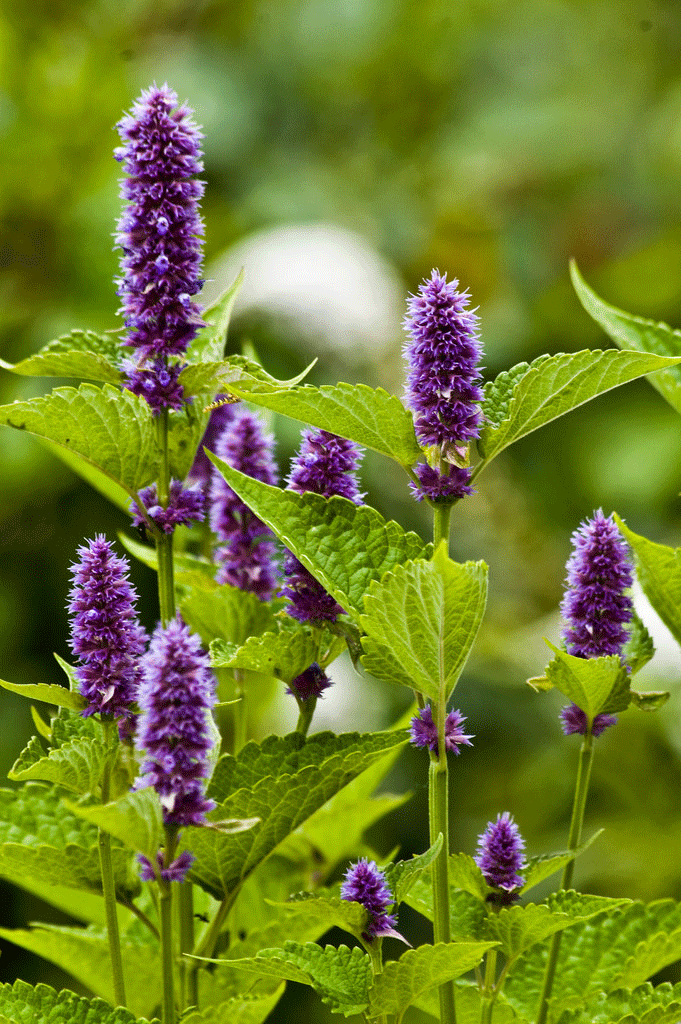Common names: Licorice mint
Latin name: Agastache foeniculum
Latin and common family names: Lamiaceae (Mint family)
What’s in a name? Neither anise (Pimpinella anisum) nor hyssop (Hyssopus officinalis), this handsome herb is actually a cousin to the mints, most closely resembling catnip in size and growth habit. It is a 2- to 3-foot bush with erect, branching, square stems that rise from a dense root clump. Its 3-inch leaves are opposite, notched, pointed, and soft to the touch. Rubbed between the fingers, they give off a pleasant fragrance that hints at their delicious flavor, a combination of sweet anise and root beer, perfect for garden sampling. The leaves are tinged with lavender, especially at the growing tips, and the color is echoed in 2- to 4-inch spikes of densely packed lavender blue florets. Each flower head produces copious amounts of tiny, rounded brown seeds. Seedlings germinate in May when the soil warms to about 60°F and can be recognized by their opposing pairs of crinkly, ruffled leaves with light lavender veining.
Planting information and cultural directions
Anise hyssop prefers full sun and humus-rich soil with abundant moisture, but also grows well in partial shade and drier soils. Adding compost, well-rotted manure, or organic fertilizer before planting helps to produce vigorous, healthy plants. They are hardy to about 15°F, but do not always survive the winter, either because of poor drainage or mysterious factors.
Propagation
Anise hyssop is easy to start from seed, sown in flats or in the ground in early spring. Cover the seeds with ¼ to ½ inch of soil and keep them evenly watered. Plants reseed in the garden but do not become weedy, perhaps because the ripe seed is a favorite of small birds.
Year-round care
Protect small and newly emerging plants from slugs, and keep them weeded until they are no longer vulnerable. Sidedress with fertilizer about once a month. These naturally shapely plants do not need pruning, but pinching back the tips encourages the production of tender growth. Allow the flowers to ripen into seed heads if you wish, but cut back the woody stems when you do your autumn garden cleanup. It may be helpful to label the plants so you will remember where they will be coming up when winter is over.
Pests and diseases
Many a gardener has blamed the demise of her anise hyssop plants on winter’s cold when slugs were the real culprits. Vigilance is the key here, because these pests not only mow down the seedlings but return to feast again and again on newly emerging shoots. Look out especially for tiny gray slugs that seem innocent but wreak havoc, and thwart them by whatever method you prefer.
Harvesting and preserving
Gather the fresh tips of anise hyssop as needed, using your thumbnail or a clipper to pinch them from the stems above the second or third pair of leaves. To dry leaves for tea, cut the stems at the base of the plant and hang in bunches of about six stems, fastened with a rubber band. In two to three weeks, strip leaves from the stems and store them in glass jars with tight-fitting lids.
Garden uses
A mature anise hyssop in bloom, is a striking plant and one of the very best nectar producers for honeybees. It is a fine addition to the edible landscape with its lavender-tinged leaves, compact habit, and the strong vertical lines of its flower spikes. It is showy enough for the flower garden, under roses, paired with the long-blooming Siberian wallflower ‘Bowles Mauve,’ or true geraniums in rose and purple hues. In the herb garden, try growing it with lavender or echinacea. For a lovely effect in a large planter, let it rise above a cascade of peppermint-scented geraniums or beside the upright ‘Mabel Grey,’ with cherryor apricot-colored nasturtiums hanging down in brilliant contrast.
Culinary uses
The tender tips of anise hyssop, picked with the young flower buds, are one of the best-tasting additions to a summer greens mixture. You can also make an excellent tea by pouring boiling water over a large handful of leaves; serve it iced, straight up, or combined with Earl Grey tea. Four Seasons chef James Walsh played up the anise flavor in an anise hyssop sorbet with a splash of Sambuca liqueur.


